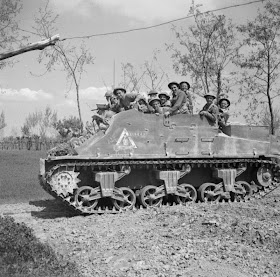Transporte de tropas blindado canadiense
Kangaroo
El transporte de tropas blindado
Kangaroo fue una propuesta para proveer de un vehículo de estas características
a las tropas británicas y de la Commonwealth. Los primeros Kangaroos fueron
convertidos partiendo de lote de 102 chasis del cañón autopropulsado M7 Priest
entregados por tres regimientos de artillería de campo de la 3º División de
infantería canadiense, que participó en el asalto inicial del 6 de junio de
1944. Estos vehículos fueron sustituidos por cañones remolcados QF 25-pounder a
finales de julio. Por su parte, en el taller de campaña (denominado en clave
como Kangaroo) se procedía al desmontaje de los cañones de 105 mm de los M7
para desarrollar su nuevo cometido de transporte de tropas. Su primer uso
operativo tuvo lugar el 8 de agosto de 1944 durante la Operación Totalize, al
sur de Caen, para complementar el número de semiorugas disponibles.
Tenía una tripulación de dos
hombres y podía transportar hasta 10 hombres totalmente equipados. Los primeros
ejemplares estaban armados con una ametralladora de calibre 50 y otra de
calibre 30 para su autodefensa pero en los modelos posteriores se sustituyó por
dos de calibre 30. La motorización era dispar y correspondía al chasis del que
se realizó la conversión (Ram, Sherman, Priest, etc.)
La mayoría de los vehículos
convertidos fueron M7 Priest o carros de combate Ram de origen canadiense. En
el otoño de 1944 fueron utilizados en los ataques canadienses a diversos
puertos de Canal de la Mancha por parte del 1st Canadian Armoured Personnel
Carrier Squadron y el 49º Armoured Personnel Carrier Regiment bajo la 79º
División acorazada británica. El Kangaroo gozó de una excelente movilidad
obteniendo ventaja sobre el resto de vehículos de su clase, de este modo los
diseños posteriores a la guerra partieron de su base.
Un Priest Kangaroo de la 209º Batería autopropulsadas, Royal Artillery, transporta soldados de la 78º División de Infantería cerca Conselice, Italia, 13 de abril de 1945
Fuentes:
FOSS, C. “The Encyclopedia of Tanks and Armored
Fighting Vehicles” Thunder Bay Press, 2002
CHAMBERLAIN, P. “British and American Tanks of World War Two: The Complete Illustrated
History of British, American and Commonwealth Tanks, 1939-45” Cassell, 2000
WARE, P. “British
tanks: The Second World War” Pen and Sword, 2012
English versión
The Kangaroo armored troop transport was a
proposal to provide a vehicle of this nature to the British and Commonwealth. The Kangaroos were
converted starting first batch of 102 chassis
M7 Priest self-propelled gun delivered three field
artillery regiments of the 3rd Canadian
Infantry Division, who participated in the initial assault
of June 6, 1944. These
vehicles towed guns were replaced
by QF 25-pounder
in late July. Meanwhile, in the workshop of campaign (referred to as Kangaroo
key) they proceeded to removal of the guns of 105 mm from the M7
to develop their new troop commitment. His first
operational use took place on August
8, 1944 during Operation Totalize,
south of Caen, to complement the number of half-tracks available.
It had a crew of two men and could carry up to 10 fully equipped men. The first units were armed with 50-caliber machine gun and a 30 gauge for self-defense but later models were replaced by two 30 gauge. The engine was mixed and matched to the chassis of the conversion is performed (Ram, Sherman, Priest, etc.).
Most were converted vehicles or M7 Priest Ram tanks of Canadian origin. In the fall of 1944 were used in the attacks at various ports Canadians Channel by the 1st Canadian Armoured Personnel Carrier Squadron and the 49th Armoured Personnel Carrier Regiment under the British 79th Armoured Division. The Kangaroo enjoyed getting excellent mobility advantage over other vehicles in its class, thus the post-war designs departed from its base.
Ram Kangaroo
Sources:
FOSS, C. “The Encyclopedia of Tanks and Armored
Fighting Vehicles” Thunder Bay Press, 2002
CHAMBERLAIN, P. “British and American Tanks of World War Two: The Complete Illustrated
History of British, American and Commonwealth Tanks, 1939-45” Cassell, 2000
WARE, P. “British
tanks: The Second World War” Pen and Sword, 2012




Felicidades por el blog, lo primero.
ResponderEliminarCuriosos tema el propuesto aquí. Me he peinado miles de hojas, horas de video y km en diferentes viajes y nunca había oido nada acerca de esta serie de modificaciones.
Muchas gracias por tus palabras, realmente se trata de un vehículo peculiar.
ResponderEliminarUn cordial saludo.